| Article ID | Journal | Published Year | Pages | File Type |
|---|---|---|---|---|
| 5760054 | Journal of Theoretical Biology | 2017 | 13 Pages |
Abstract
The reconstruction of phylogenetic trees from discrete character data typically relies on models that assume the characters evolve under a continuous-time Markov process operating at some overall rate λ. When λ is too high or too low, it becomes difficult to distinguish a short interior edge from a polytomy (the tree that results from collapsing the edge). In this note, we investigate the rate that maximizes the expected log-likelihood ratio (i.e. the Kullback-Leibler separation) between the four-leaf unresolved (star) tree and a four-leaf binary tree with interior edge length ϵ. For a simple two-state model, we show that as ϵ converges to 0 the optimal rate also converges to zero when the four pendant edges have equal length. However, when the four pendant branches have unequal length, two local optima can arise, and it is possible for the globally optimal rate to converge to a non-zero constant as ϵâ0. Moreover, in the setting where the four pendant branches have equal lengths and either (i) we replace the two-state model by an infinite-state model or (ii) we retain the two-state model and replace the Kullback-Leibler separation by Euclidean distance as the maximization goal, then the optimal rate also converges to a non-zero constant.
Related Topics
Life Sciences
Agricultural and Biological Sciences
Agricultural and Biological Sciences (General)
Authors
Mike Steel, Christoph Leuenberger,
